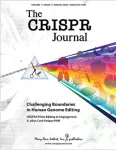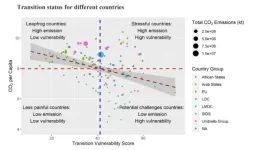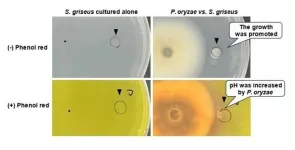(Press-News.org) Magnetic resonance imaging (MRI) can spare many patients with rectal cancer from invasive surgery that can carry lifelong side effects, new research indicates.
The findings, from UVA Cancer Center’s Arun Krishnaraj, MD, MPH, and collaborators, indicate that MRI can predict patient outcomes and the risk of the tumor reccurring or spreading for patients who have undergone chemotherapy and radiation.
That information could be extremely useful in determining the best course of treatment and deciding whether a patient can avoid surgery in favor of a “watch and wait” approach, the researchers say. In watch-and-wait, doctors continue to monitor patients for cancer reccurrence or spread, holding off on surgery but potentially leaving them uncertain and anxious about the future.
The information MRI can provide would be both useful for doctors and comforting for patients, the new findings suggest.
“After undergoing chemotherapy and radiation for rectal cancer, patients are understandably concerned whether their cancer is gone or whether there may be some leftover disease. Using newer MRI techniques, we are now able to predict much better than in the past whether any cancer remains and, if so, whether it will come back and spread,” said Krishnaraj, a radiologist and imaging expert who is director of UVA Health’s Division of Body Imaging, among other leadership positions. “No one wants to get surgery if they can avoid it. Now we have a powerful tool to help patients and their doctors predict who would benefit from surgery after initial chemotherapy and radiation and who can likely avoid surgery.”
Better Care for Rectal Cancer
Colorectal cancer is increasing among younger adults – those under 50 -- even as it has been decreasing among older people. It’s estimated that the disease will strike approximately 1 in 23 men and 1 in 25 women, according to the American Cancer Society.
Rectal cancer is typically treated at first with radiation and chemotherapy, but some patients require what is known as “total mesorectal excision” – the removal of a substantial portion of their bowel. This can be lifesaving but it can also be life-changing: Side effects can include the need for a permanent colostomy bag and sexual dysfunction.
To help patients make the best choices and get the best outcomes, Krishnaraj and his collaborators wanted to see if MRI could serve as a crystal ball for the effects of watch-and-wait. To do this, they analyzed the results of the Organ Preservation in Renal Adenocarcinoma (OPRA) trial to see how MRI results aligned with patient outcomes. In total, they reviewed outcomes from 277 patients, with an average age of 58, who had the stage of their rectal cancer determined by MRI. The average length of the follow-up period was slightly more than 4 years.
After crunching the numbers, the researchers determined MRI was an effective tool for predicting the patients’ overall survival, the risk of their cancer returning and their chances for keeping their bowel intact.
The promising MRI crystal ball can likely be made even more effective by combining it with data from endoscopies (visual inspections) after treatment, the OPRA Consortium researchers say. They are urging additional research on the potential of the combination, which they believe could offer doctors and patients a powerful new tool.
“I am optimistic that continued advancement in MRI and other tools like endoscopy will provide better information about future outcomes,” Krishnaraj said. “Ultimately, I would love to get close to 99% predictive probability in better informing our patients about their potential risk for recurrence or spread of their cancers following treatment. We may not be there quite yet, but that is our goal.”
Developing new ways to improve patient care is an essential mission for UVA Cancer Center, one of only 57 cancer centers designated as “comprehensive” by the National Cancer Institute. The designation honors elite cancer centers with the finest cancer care and research programs in the nation.
Findings Published
The OPRA Consortium researchers have published their findings in the scientific journal Radiology. A complete list of the authors and their disclosures is included in the paper.
To keep up with the latest medical research news from UVA, subscribe to the Making of Medicine blog at http://makingofmedicine.virginia.edu.
END
MRI can save rectal cancer patients from surgery, study suggests
2024-10-22
ELSE PRESS RELEASES FROM THIS DATE:
Fyodor Urnov on clinical crisis in CRISPR genome editing
2024-10-22
New Rochelle, NY, October 18, 2024—An invited Guest Editorial entitled “Give Cas a Chance,” by Fyodor Urnov, PhD, Director of Technology & Translation at the Innovative Genomics Institute (IGI), anchors the October 2024 special issue of The CRISPR Journal on “CRISPR Trials.”
As guest editor of the special issue, Dr. Urnov has penned an extraordinary editorial that emphatically defines the magnitude of the crisis in the genome editing arena and offers a path forward. The inherently programmable nature of CRISPR gene editing that makes it ...
People with type 2 diabetes who eat low-carb may be able to discontinue medication
2024-10-22
WASHINGTON—Adults with type 2 diabetes on a low-carbohydrate diet may see benefits to their beta-cell function allowing them to better manage their disease and possibly discontinue medication, according to new research published in the Endocrine Society’s Journal of Clinical Endocrinology & Metabolism.
Beta-cells are endocrine cells in the pancreas that produce and release insulin, the hormone that controls blood sugar levels.
More than 38 million Americans have diabetes, and over 90% of them have ...
Air pollution linked to having a peanut allergy during childhood
2024-10-22
Exposure to higher levels of air pollution as a baby is linked to having a peanut allergy throughout childhood, according to a new study. And policies aimed at tackling poor air quality could potentially reduce the prevalence and persistence of peanut allergies, it stated.
The research, led by Murdoch Children’s Research Institute (MCRI) and the University of Melbourne, found being exposed to higher levels of air pollution from infancy was associated with increased odds of developing a peanut allergy and having the allergy persist across the first 10 years of life. However, the same association was not seen for egg allergy or eczema.
Published ...
Dangers of the metaverse and VR for US youth revealed in new research
2024-10-22
The metaverse, a space where the lines between physical and digital realities blur, is rising among younger populations. As of March, 33% of teens own a virtual reality (VR) device and 13% use it weekly.
With the metaverse offering richer emotional experiences, youth may be particularly vulnerable to significant harm in these immersive spaces, underscoring the need to explore potential risks.
Unfortunately, research of online victimization in the metaverse is sorely lacking. A new study by Florida Atlantic University, in collaboration with the University of Wisconsin-Eau Claire, is one of the first to examine the ...
A national indicator for a just energy transition
2024-10-22
The Energy Transition Vulnerability Index (ETVI) quantifies the vulnerability of nations to adverse impacts of transitioning away from fossil fuels. The COP28 agreement has called for all countries to wind down use of fossil fuels to combat climate change—but the agreement stipulates that these transitions should not disproportionately harm historically marginalized and vulnerable stakeholders. Xunpeng Shi and colleagues create a method of quantifying energy transition vulnerability for 135 countries from 2010 to 2020. The indicator focuses on exposure—which captures the magnitude of the changes required—, ...
Cognitive effort whets the appetite for reward
2024-10-22
Mental fatigue may make rewards more desirable, according to a study in rats and humans. Exerting cognitive effort has been linked with making unhealthy choices. In the past, the link has been explained via a weaking of inhibitory control or will power. Marcello Solinas and colleagues explore the possibility that cognitive effort may also make unhealthy choices more tempting by increasing the perceived reward. Rats who completed a cognitively demanding task self-administered more cocaine than rats who did not complete a cognitive demanding task—or rats who were allowed ...
European funders and organizations partner to promote sustainable research
2024-10-22
A significant step forwards in changing research practices towards sustainability has been taken with the publication of the Heidelberg Agreement on Environmental Sustainability in Research Funding. The agreement provides a framework for research funders to play an active role and incentivize sustainable practices in research. It outlines principles for transitioning to a more sustainable research system and practical recommendations on how to implement sustainability in funding schemes.
A key focus of the Heidelberg Agreement is to ensure that research funders take a proactive approach to promoting sustainability in scientific ...
A model for the decline of trends, fads, and information sharing
2024-10-22
A model of human behavior finds that people will share information if enough—but not too many—of their contacts do so. Humans are social creatures, and many behaviors and beliefs can spread from person to person. Understanding the dynamics of behavioral diffusion can help encourage healthy or sustainable behaviors or stop the spread of misinformation. Linear threshold models assume that people will adopt a behavior when the number of their social contacts that have done so passes a threshold. Pouria Ramazi and colleagues propose an addition to the model, ...
Plastic mulch is contaminating agricultural fields
2024-10-22
Using plastic sheets for weed control, even under current best management practices, pollutes soil with macro- and micro-plastics and negatively affect critical soil functions, according to a study. The United Nations considers soil plastic contamination an environmental health and food security threat. Around the world, over 25 million acres of farmland is seasonally covered with opaque plastic films used as “mulch” to prevent weeds, retain moisture, and warm soil—a practice known ...
Scientists discover how fungi interact with soil actinomycetes
2024-10-22
In the world of agriculture, rice is a staple food for more than half of the global population, making its cultivation crucial for food security. However, the rice blast fungus Pyricularia oryzae (syn. Magnaporthe oryzae) poses a significant threat to rice crops, causing extensive damage and leading to substantial yield losses. Traditional methods of controlling this pathogen often rely on chemical fungicides, which can have detrimental environmental impacts and contribute to the development of resistant strains. Therefore, researchers are increasingly exploring alternative strategies that leverage natural ...







